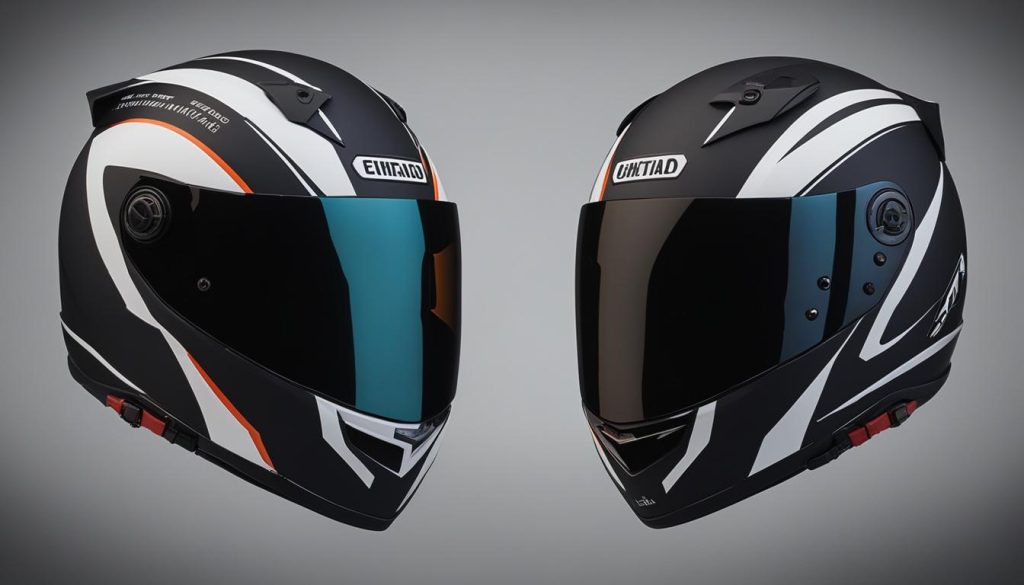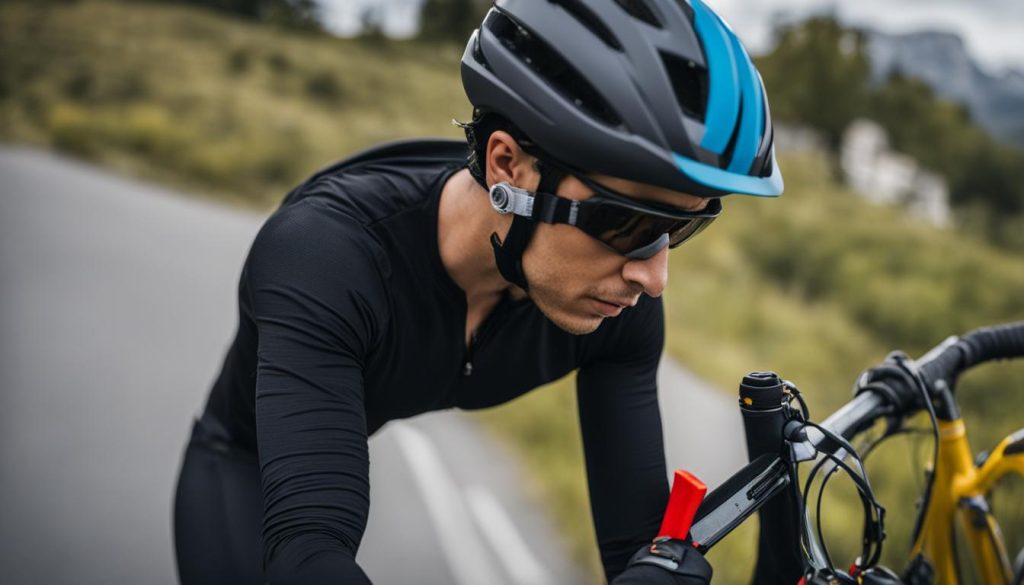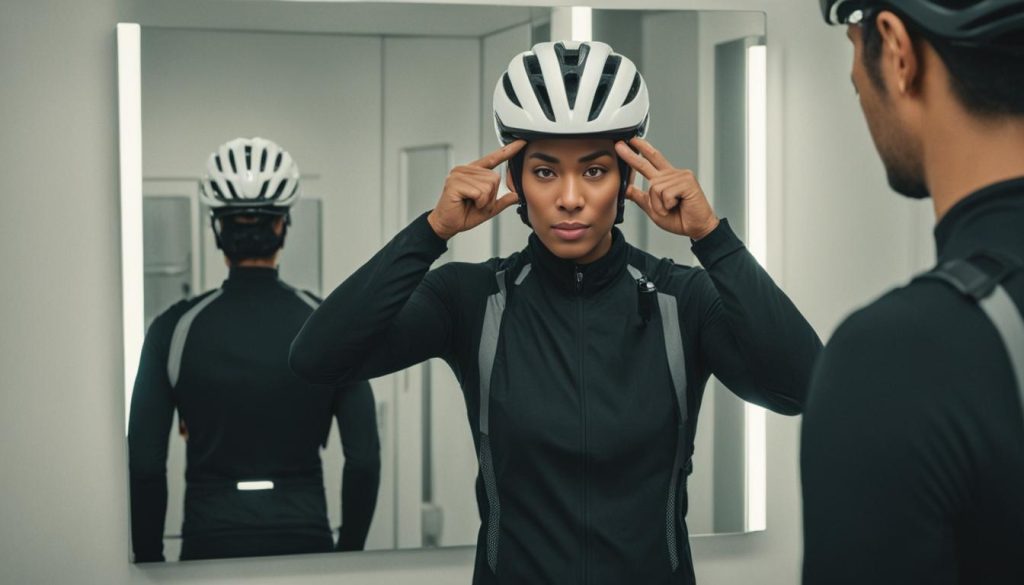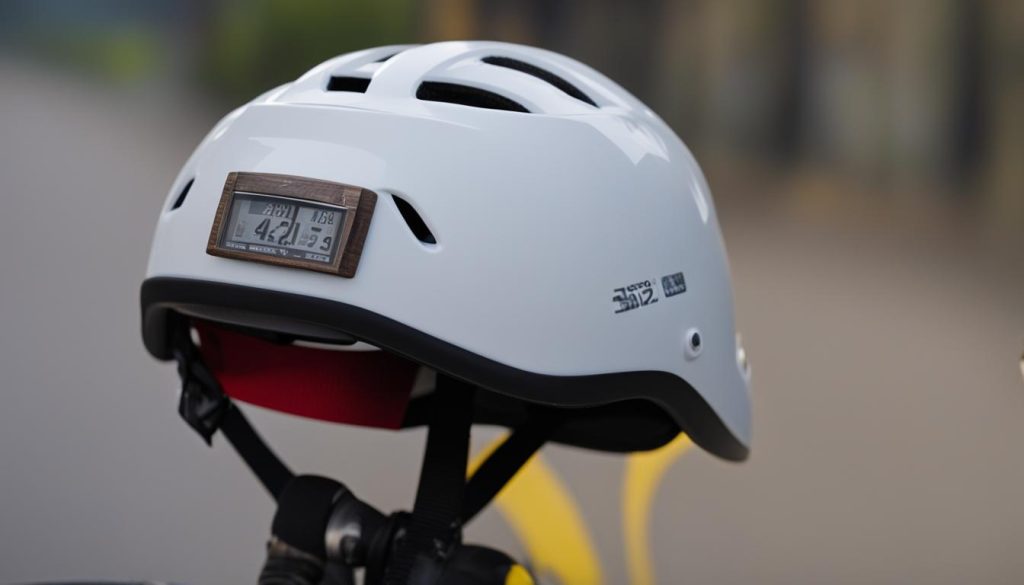Are you confident that your bike helmet fits you correctly? A properly fitting helmet is essential to keep you safe while cycling, and it can also ensure that you’re comfortable on the road. In this article, we’ll explore the importance of a bike helmet fit and provide you with expert tips on how to ensure that your helmet suits you perfectly.
According to the Bicycle Helmet Safety Institute, a well-fitting helmet should cover your forehead, and the strap should be snug enough to prevent it from moving more than an inch in any direction.
Key Takeaways:
- A properly fitting bike helmet is essential for safety and comfort while cycling.
- Having a poorly fitting helmet can compromise your protection in case of an accident.
- Measuring your head size accurately and checking the fit while wearing the helmet are crucial steps in ensuring that your helmet suits you perfectly.
- Remember, a properly fitted helmet can significantly reduce the risk of head injuries.
- Check the fit of your helmet regularly and replace it if it’s damaged or doesn’t fit you anymore.
Why is Helmet Fit Important for Safety?

When it comes to cycling safety, the significance of a well-fitting helmet cannot be overstated. A properly sized helmet provides the necessary protection to prevent serious head injuries, while an ill-fitting helmet can compromise your safety in case of an accident.
The risks of using a poorly fitting helmet include:
- Increased risk of head injury
- Narrowed field of vision, potentially leading to inadequate awareness of surroundings
- Helmet slipping and/or shifting during a ride, which can impair vision, cause discomfort, and reduce protection levels
These are just a few examples of what can happen when a helmet does not fit correctly. To ensure maximum safety while cycling, proper helmet sizing is key.
When fitting your helmet, be sure to take into account the following factors:
- The circumference of your head, which determines the helmet size
- The position of the helmet on your head, ensuring it fits snuggly and comfortably on your forehead, with straps tightened but not too tight, and with no gaps
- The overall feel of the helmet to make sure it is not too loose, not too tight, or too heavy
Remember, a well-fitting helmet can make all the difference between a minor accident and a major injury. Take the time to ensure that your helmet is properly sized and fitted to your head shape to ensure maximum protection and safety during your rides.
How to Properly Fit Your Bike Helmet

Ensuring that your bike helmet fits properly is key to maximising both safety and comfort while cycling. Here’s a step-by-step guide on how to get the right fit:
-
- Measuring Your Head Size
Before you purchase a helmet, you must measure your head to ensure that you get the correct size. Here’s how to do it:
| Step | What to Do |
|---|---|
| 1 | Wrap a measuring tape around the fullest part of your head, just above your eyebrows and ears. |
| 2 | Note the measurement and use it to find the corresponding helmet size in the manufacturer’s size chart. |
-
- Checking Helmet Fit
Once you have your helmet, you need to ensure that it fits correctly. Follow these steps:
- The helmet should sit level and evenly on your head.
- The front should sit about an inch above your eyebrows to protect your forehead.
- The straps should be snug against your chin without being uncomfortable.
- The helmet should fit snugly but not be too tight; it should not move around on your head when you shake it or nod.
- The helmet should cover the back of your head and not shift forward during cycling.

- Helmet Fit Tips and Checklist
Here are some tips to ensure the best possible fit:
- Some helmets come with fit pads that can help you get a better fit.
- Make sure that the helmet straps are adjusted correctly.
- Choose a helmet that suits your head’s shape.
- Check the ventilation and adjustability of the helmet.
Use this checklist to make sure your helmet is secure and comfortable:
- The helmet is level and covers the forehead.
- The straps are straight, snug, and form a V under your ears when buckled.
- The chin strap is adjusted with enough room to fit a finger in between the strap and your chin.
- The helmet doesn’t move when you shake your head from side to side and up and down.
- If it has a visor, it blocks the sun from your eyes while cycling.
Following these guidelines can help you ensure that your helmet is properly fitted and provides the maximum possible protection and comfort while cycling.
Conclusion
Now that you’ve read our bike helmet fit guide, you may be wondering, “How do I know if my bike helmet fits me?” Remember that a properly fitting helmet should feel snug and secure on your head without being uncomfortable. It should not move around or shift while you ride.
You can use our helmet fit checklist to ensure that your helmet is safe and comfortable for your rides. Always measure your head size accurately and choose a helmet that is the right size for you. And if you’re unsure about the fit, don’t hesitate to consult with a professional or the manufacturer’s guidelines.
Investing in a well-fitting bike helmet is crucial for your safety on the road. So, use our guide to get the perfect fit and ride with confidence. Happy cycling!
FAQ
How do I know if my bike helmet fits me?
To determine if your bike helmet fits you correctly, follow these steps:
1. Measure the circumference of your head just above your eyebrows with a tape measure.
2. Check the helmet’s size chart to find the appropriate size for your head circumference.
3. Try on the helmet and ensure it sits level on your head without tilting.
4. Adjust the straps so they form a V-shape just below your ears.
5. The helmet should feel snug, with no excessive movement or pressure points.
6. Shake your head side to side and up and down to make sure the helmet stays securely in place.
7. Finally, consult the helmet fit checklist to ensure you have considered all the necessary factors for a proper fit.
Why is helmet fit important for safety?
Having a proper helmet fit is vital for your safety while cycling. A well-fitting helmet will stay securely in place during impact, reducing the risk of head injuries. A poorly fitting helmet, on the other hand, can shift or come off, leaving your head vulnerable to injury. Additionally, an ill-fitting helmet may not provide adequate coverage for essential areas of your head, compromising its protective capabilities. Ensuring your helmet fits properly is crucial to maximize its effectiveness in protecting your head in case of an accident.
How do I properly fit my bike helmet?
Here are some steps to properly fit your bike helmet:
1. Place the helmet on your head, ensuring that the front is level and sits just above your eyebrows.
2. Adjust the straps so they form a V-shape just below your ears.
3. Tighten the straps until the helmet feels snug but not too tight, with no gaps between the helmet and your head.
4. Check the helmet’s stability by shaking your head gently from side to side and up and down. The helmet should stay securely in place.
5. Assess the helmet’s fit by looking in a mirror or trying to slide your fingers between the helmet and your forehead. There should be minimal movement.
6. If necessary, use the helmet’s adjustment mechanisms to customize the fit further.
Remember to consult the helmet fit checklist to ensure you have covered all the necessary aspects of a proper fit.
What are some helmet fit tips?
Consider these helmet fit tips for a secure and comfortable fit:
1. Try on different helmet brands and models to find the one that suits the shape of your head best.
2. Choose a helmet with adjustable straps and fit systems to fine-tune the fit.
3. If you wear glasses, ensure that the helmet doesn’t interfere with their fit and position.
4. Avoid wearing anything bulky or thick underneath your helmet, as it can affect the fit.
5. Replace your helmet if it becomes damaged or after a significant impact, as it may no longer provide adequate protection.
What should I include in a helmet fit checklist?
Your helmet fit checklist should include the following factors:
1. Head circumference measurement and corresponding helmet size.
2. Proper helmet positioning, with the front sitting just above your eyebrows.
3. Secure and properly adjusted straps forming a V-shape just below your ears.
4. Snug fit without gaps between the helmet and your head.
5. Stable helmet that doesn’t move excessively when shaking your head.
6. Minimal movement of helmet when trying to slide fingers between the helmet and your forehead.
7. Comfortable fit without any pressure points.
8. Compatibility with glasses, if you wear them.
9. Helmet not interfering with your field of vision.
10. Compliance with relevant safety standards, such as CPSC or ASTM certifications.
By following this checklist, you can ensure that your bike helmet fits you properly and provides maximum safety and comfort.





